Chris Kridler
Chris Kridler is a writer, photographer and storm chaser and author of the Storm Seekers Series of storm-chasing adventures.
Chris Kridler is a writer, photographer and storm chaser and author of the Storm Seekers Series of storm-chasing adventures.
I can’t believe I’ve only been in Tornado Alley for three days. I’m already seriously sleep-deprived, and I haven’t had time to edit any of the video I’ve shot. (Note/edit: Video has been added!)
But I did just post photos from yesterday’s epic chase with friends, from a storm near Ness City, Kansas, to the last two tornadoes from a storm west of Larned, Kansas, near Rozel – both on the ground at once!
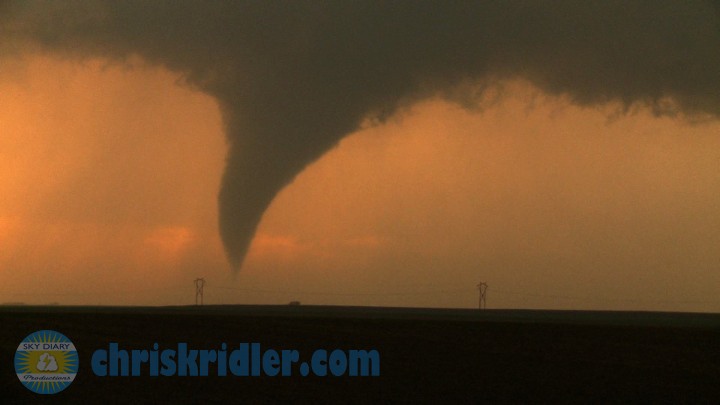
The cone lasted several minutes.
Roll over a photo to see its caption, and click on any of the pictures to start a slide show of larger images.
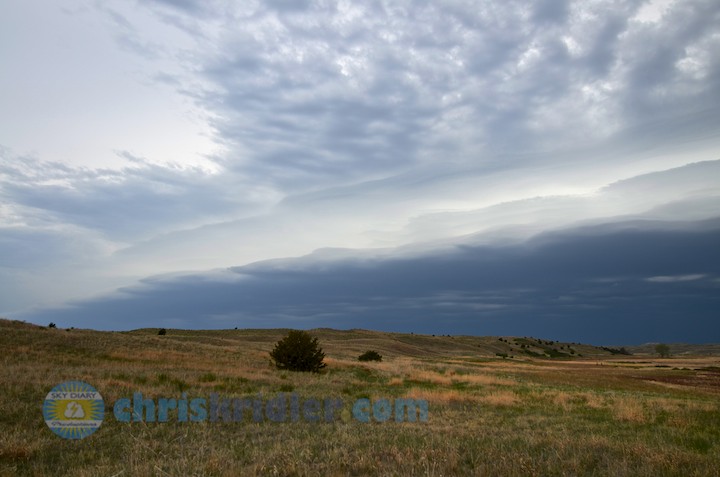
A shelf cloud in Nebraska. Photo by Chris Kridler, ChrisKridler.com
I chased today with Greg Stephens, Dayna Vettese and Brad Rousseau, eventually meeting up with Dave Lewison and Scott McPartland in Valentine, Nebraska, in the vicinity of our initial target.
Storms fired and were more pretty than violent, especially against the backdrop of north-central Nebraska’s rolling hills. A shelf cloud developed, and down the road from the group, I watched it march across the plains.
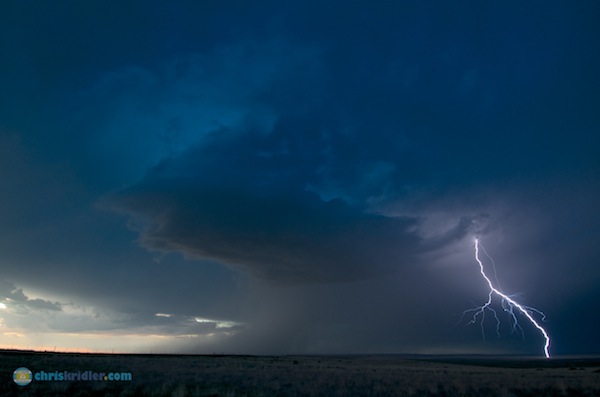
This pretty storm and its brothers produced prolific lightning at twilight south of Oakley, Kansas. Photo by Chris Kridler, ChrisKridler.com, SkyDiary.com
On the second day of my Tornado Alley sojourn, meant to get me in position for subsequent chases, I managed to catch up with a cluster of pretty storms in northwest Kansas.
The storms were, at one time, severe, but when I photographed them in a gorgeous twilight, they were simply prolific lightning producers.
Roll over a photo to see its caption, and click on any of the pictures to start a slide show of larger images.

Here’s a closeup of where lightning damaged the palm tree. Photo by Chris Kridler, SkyDiary.com, ChrisKridler.com
I was at a party and went outside to shoot photos of the approaching storm. The lightning became very intense as it neared, so I retreated from the home’s driveway to the alcove at the front door. Note: This is not a safe shelter from lightning, but I felt less exposed there.
I shot a little video, then switched to stills, just before a lightning bolt hit a tree just on the other side of the home’s garage. The flash and bang were instantaneous – what storm chasers call a “flang” – and it scared me thoroughly. I was lucky it didn’t hit any closer.
Afterward, I got photos of the palm tree that was damaged. There was a hole blasted in its trunk.
The storm became severe-warned and caused a lot of minor wind damage.
Roll over a photo to see its caption, and click on any of the pictures to start a slide show of larger images.
You can tell it’s been a dull storm-chasing season for Tornado Alley, at least so far. Storm chasers on social media are posting a lot of “from the vault” and computer-model-related posts and not much in the way of recent storms.
In the last year – May 2012 to April 2013 – there have been just seven reported tornado-related deaths in the United States, Harold Brooks reports on NOAA’s U.S. Severe Weather Blog. That’s the lowest 12-month number since 1899.
What’s good for the public in terms of gentle weather is pretty dull for weather fanatics – who would prefer to see tornadoes in unpopulated areas – but Italy is picking up the slack. Several tornadoes struck in the Emilia-Romagna region in northern Italy on May 3, a date that shall go down in infamy in the States as the anniversary of the deadly 1999 outbreak, including the F5 that devastated Moore, Oklahoma.
I’ll be heading out to Tornado Alley soon, I hope. There will likely be interesting storms there this week, but I’m still waiting for a more active period … or I will take my chance on what comes, perhaps as soon as next week.
The line between erotica and the rest of fiction keeps blurring with the advent of such genres as New Adult and the mainstreaming of sexy books. While this phenomenon doesn’t mean that all books are trending toward the titillating, it does make a writer stop and think about how to write such scenes better.

It doesn’t pay to be coy. (Painting by Sir Lawrence Alma-Tadema)
Even if your writing hasn’t strayed that far into the bedroom, at some point you have to face the question of whether and how to write a sex scene. Such scenes are difficult to do well and even more difficult to craft objectively, given their nature — for, done well, they are intimate not just physically, but emotionally.
Sex scenes have always been around, in various states of undress and literary merit. I’m a proponent of the idea that a great book is a great book, no matter what its genre, but great sensual books are scarce. A lot of them are hilariously formulaic; have you seen Siren’s publication guidelines? Some sex scenes are intentionally silly; others are robotic, awkward, or drunk with kooky metaphors. As a reader, I’ve found consuming books labeled erotica is a lot like eating french fries. Soon after, I feel undernourished and slightly guilty for not ordering a salad. I want substance with my sensuality. Combining the two makes for a more powerful reading experience.
The challenge any writer faces when dealing with physical intimacy in a story is meeting his or her goals in terms of what he/she’s trying to deliver. If you want to write a searingly erotic novel that also is a compelling exploration of theme and character, you’re a rare writer (and probably someone I want to read). If you just throw sex scenes into your book because you think it’s something the reader wants, but you aren’t really inhabiting the scenes in any meaningful way, then you’re not fulfilling the story’s potential. Or maybe you deliberately write “clean” for a certain kind of audience, and that’s a choice, too. Whatever your choice, you need to write to your comfort level, as long as it’s not holding you back as a writer.
I want a novel to nourish my soul and entertain me, and I want to write that way, too. I have that English-major (slash-journalism-major) background that compels me to impart a story with what I hope are literary themes and values, even if there’s a good deal of plot and, to get back to the point, some sex. I don’t see sex scenes as some sort of hot lava cake served with a fish-and-broccoli dinner (to abuse the food metaphor further) just to make it more mouth-watering. Sex scenes offer an opportunity to advance the characters and their relationships, to illuminate their expectations and ability to communicate with others, and to immerse the reader inside their heads. Sexual encounters, whether good or ill, are among the most intimate and powerful experiences people can have, thus they are invaluable fodder for a writer who wants to pull the reader as, ahem, deeply into the characters as possible.
There’s a broad range of stories that use intimate scenes well and creatively. In literary history, perhaps the most lauded sensual novel is D.H. Lawrence’s “Lady Chatterley’s Lover,” which was published privately in 1928 but wasn’t published openly in the U.K. until 1960 because of its forbidden words and sexy scenes (says Wikipedia). Compared with today’s erotica, now perhaps unfortunately defined by “Fifty Shades,” it seems ridiculously tame. I find Lawrence much more meaningful than most of what passes as erotica, as he deals with themes of balancing mind and body and transcending class. Of course, books don’t have to be on a college syllabus to get sex right, and usually aren’t; note the well-written popular romance novels of Roxanne St. Claire, whose books have indubitably hot sex scenes that are crucial to her characters’ inner turmoil and eventual commitment to each other.
There’s certainly no need to justify sex scenes, but I’m not crazy about bad ones. As writers, we should strive to make them great. My novels are about a whole lot more than sex, but they contain sex scenes; I hope they’re memorable, but they are only about three percent of the latest book. They’re part of the story because sex scenes help illuminate relationships. Connections between people – including missed connections – offer ways for individual characters to learn about themselves. Still, like most of us, I worry about getting the writing right. I’ve been a little surprised, if not discomfited, by readers’ reactions to the sex scenes in my newest novel. I’ll gratefully accept descriptors of “steamy” and “sizzling,” but I don’t want those scenes to define or unbalance the rest of the book.
I think all writers gain perspective on their book in subsequent drafts, but intimate scenes can be among the most difficult to look at with objectivity. Total objectivity can leach them of spontaneity and emotion. Yet I tweak those scenes endlessly to shape their rhythm and meaning, in hopes the reader will experience the shifting feelings between the characters and their inner justifications and thoughts, as well as their primal yearnings. A beta reader, writers’ group or editor can help you identify when these scenes go off the rails, or if something strikes a sour note. Sometimes that reader will help you hear the little bell that was ringing in your subconscious, telling you something wasn’t quite right. Intimate scenes are just one more reason to have that kind of feedback on your work.
If you’re a writer who’s really uncomfortable with sex scenes but wants to pen them anyway, having an honest editor is all the more important. She can help you with tone and help you see how the scene can advance your story. You need someone to give you advice who is going to be really frank with you and isn’t afraid to talk about stuff. You know, sex stuff. If you can talk about it, you can write about it. Do a little research. Opinions from the opposite sex wouldn’t hurt, either. I’m certainly not going to dictate how to write a sex scene, but I do know that sharing it before publication, while possibly painful and embarrassing, can be extremely helpful . . . even if using a certain word in my writers’ group prompted hooting and hollering and an extensive discussion of hysterically weird euphemisms for the male organ (“bawdle” was one of that evening’s inventions).
How would you label your novel’s sexual content? Does it define your book as erotica? Or does it shape the story’s drama, literary theme or romance? Is it a throwaway moment in a thriller? Not the latter, I hope. Readers will approach your scene with varying expectations, and, let’s face it, their very personal tastes will help shape their reactions, whatever you write. But whatever the intimate scene may be, as a writer, don’t throw it away. Make it meaningful and important, because it is.
Further reading:
For nitty-gritty, humorous advice on writing sex scenes, check out Delilah S. Dawson’s post at Terrible Minds.
For a hilarious Twitter discussion of ridiculous places characters have had sex (please, for F’s sake, don’t put them on a horse), see this post from Smart Bitches’ Sarah Wendell on Storify.
And feel better after reading The Guardian’s excerpts from its nominees for the Bad Sex in writing award, 2012.
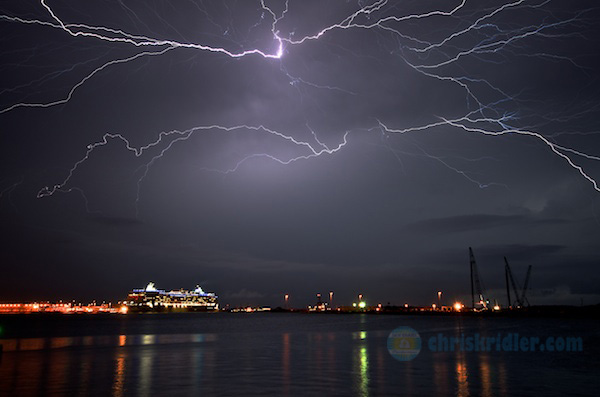
A lightning crawler lights up the sky over Port Canaveral on April 29, 2013. Photo (c) Chris Kridler, ChrisKridler.com, SkyDiary.com
I chased a severe storm the evening of April 29 in hopes of catching a little lightning. I got lucky with this shot over Port Canaveral, Florida, with a cruise ship in the foreground.
My Tornado Alley chase is on hold (shades of 2012) while the pattern continues to be un-May-like in the Plains. So any storms I get to see in Florida are a bonus.
Meanwhile, please consider subscribing to my YouTube channel. I’ve adopted the new layout, which better organizes my videos, and you’ll be able to keep track of my storm chases when I post new ones as I travel.
Roll over a photo to see its caption, and click on any of the pictures to start a slide show of larger images.
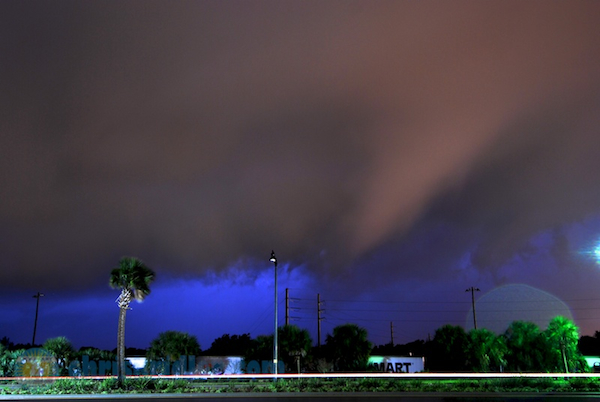
A suspicious lowering was a persistent feature of a tornado-warned storm as it approached me in Rockledge, Florida, on April 14. Photo by Chris Kridler, ChrisKridler.com
I decided to chase a decent chance of severe storms in central Florida on April 14, with at least the hope of testing my storm-chasing gear. That still needs work – and the first part of the chase was frustrating. The second was fueled with adrenaline.
Earlier in the day, I gave the Midland USA XTC-300 wearable camera a tryout during the storm-chase in central Florida on Sunday, in preparation for using it in Tornado Alley. In this short video, time-lapsed in editing, it was attached to my car with a suction-cup mount and stood up to highway speeds and rain. Video by Chris Kridler; music licensed from FootageFirm; camera courtesy Midland USA.
Sunday night, when a tornado-warned storm approached my neighborhood – with lots of attendant lightning – I decided to take a chance and see what I could get. Mostly, I wanted lightning, but the persistent rain made it hard to get a clear shot. However, I found myself in the path of a tornado-warned storm headed for Rockledge, Florida, and according to the radar, I was really in the path. The “hook echo” was pronounced and on track to collide with me. So I watched and photographed the storm with nervous anticipation.
What I saw at the time and in my photos was, shall we say, suspicious. Again, chasing at night, it’s very difficult to see and identify significant features such as funnels and tornadoes, when so-call scud clouds can mimic them easily. Yet the persistent feature in this photo (in several photos, actually) sure looked like a funnel.
The National Weather Service says there were likely two tornadoes, including one in Cocoa produced by the storm that spawned what I think was a funnel in my photographs.
Roll over a photo to see its caption, and click on any of the pictures to start a slide show of larger images. Note: Post updated with images from my old Sky Diary site.
NOTE from 2024: I wrote the original post in 2013. Since then I’ve started using an iPad with a lightweight storebought cupholder mount that works really well. This might be an option for you. Read on for one way to build your own laptop computer mount for your car or truck.

Here’s a laptop mount I made for my storm-chasing vehicle with PVC pipe and a cutting board. Photo by Chris Kridler, ChrisKridler.com, SkyDiary.com
This will be my 17th season chasing storms, and in all that time, I’ve never had a proper car mount for my laptop. Before you freak out, fear not; I’m not surfing the web while driving. But like other chasers, I like to run GPS software in conjunction with a program that displays radar information so I know whether I’m driving into a storm; basically, it’s your GPS on steroids. And when stopped, I can page through other data online.
Over the years, I’ve tried some nutty solutions: a metal rack with a 90-degree bend in it, the kind you put in a roasting pan; a child’s lawn chair; and various perches on my center console and passenger seat, depending on whether I had a chase partner. None worked well. I decided this year to get a real laptop mount – but the really nice Ram and JottoDesk mounts aren’t cheap. From what I’ve read online, I also had doubts that there would be one that perfectly fit my current model of car, a 2010 Honda Element. So I did some searching online and found this excellent page put together by Mike Davis, who built a laptop mount for his Toyota Tacoma using PVC that fits into his cup holder. I don’t know Mike, but I’m grateful to him for sharing his design with the world.
Using a cup holder almost sounded too easy. And it is, in a way. I still haven’t been able to achieve the perfect snug fit that he apparently did, but nonetheless, inspired by his design, I’ve put together a pretty functional laptop mount for less than $30. Mine isn’t exactly like Mike’s, so I think it’s worth sharing. Between Mike’s page and my page, perhaps you can find a design that will work for you. I’m no engineer (obviously!), so you’ll have to judge for yourself whether your version safely fits your needs.

PVC parts for the laptop mount: two each of different types of elbows; a drain for attaching to the tray; and a ridged piece to make it fit better in the cup holder. Photo by Chris Kridler, ChrisKridler.com, SkyDiary.com
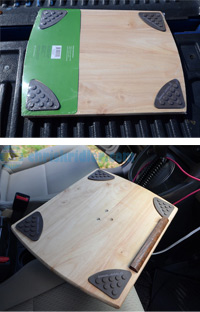
For the laptop tray, I used a cutting board that already had rubber feet, which would go on top to help hold the computer in place. A piece of quarter-round molding also helps steady the laptop. Photo by Chris Kridler, ChrisKridler.com, SkyDiary.com
First, I went to the big box store and played Tinker Toys with the PVC pipe pieces. A two-inch width was the closest to fitting into my cup holders – there are two holders between the front seats. Though you may opt for different pieces, these are the ones I chose – two 90-degree elbows, two 45-degree elbows, and a coupling with vertical ridges that gave me a little more width for a better fit in the cupholder. I couldn’t find the flange I needed to fit the laptop tray, so I bought a drain fitting. While the design that inspired me, as mentioned above, did away with the drain itself, I chose a brass drain so I could put the screws/bolts through its slots when attaching it to the tray.
For the tray, I thought a wooden cutting board might work – it would be thick and already finished, so less work for me. I found one with rubber feet (on clearance, to boot). It seemed perfect – I’d put the “bottom” with the rubber feet on top, to help keep the laptop from sliding around. After installation, the rubber pads have a pretty good grip on the laptop, though Velcro would probably do the job, too. I also nailed a small piece of quarter-round molding to one edge of the platform to keep the laptop from sliding off. Position the piece depending on how your tray is angled. Since mine tends to lean backward a bit, that’s where I put the quarter-round.
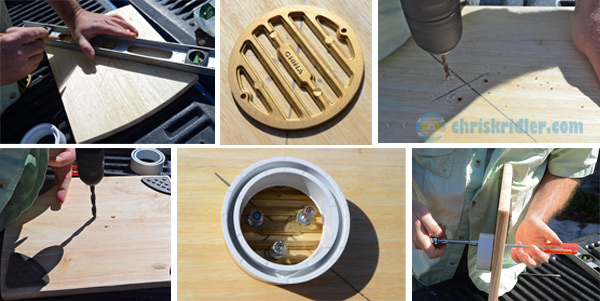
Assembling the tray involved marking the board and the bolt positions through the drain piece; drilling the holes; and applying the bolts and compression nuts and washers. Photo by Chris Kridler, ChrisKridler.com, SkyDiary.com
My husband helped with assembly of the board to the drain piece. He marked the center of the board and then marked the positions of the three bolts, using the drain as a template. He drilled pilot holes, then used a bigger bit to drill into the top holes slightly so we could counter-sink the bolts (meaning they would not stick up above the surface of the platform). Washers and compression nuts (chosen so they wouldn’t loosen with vibration) secured the bolts.

I test-fit the pipes together, marked them, then attached them with PVC primer and glue (all but the tray piece, which is not glued in my setup). I spray-painted the pipe, too. Photo by Chris Kridler, ChrisKridler.com, SkyDiary.com
Next, I worked on fitting the bottom piece with the ridges snugly into the cup holder. I’m not sure I succeeded as well as I would have liked. I used a razor knife to gradually trim away the ridges at an angle, since the cup holder is tapered. Mike’s – the one linked above – involves less pipe because the cup holder is higher, so it may be inherently more stable.
I marked the pipes where I wanted them attached, pulled them apart, then used PVC primer and glue to stick them together. I spray-painted the pipe (without the drain/tray piece) a dark brown (I like to think of it as a steampunk brown – ha ha!) so it would blend into the car’s interior a little better.
I did NOT glue the drain/tray piece onto the rest of the pipe, so that I can adjust the angle of the tray if I want to. After some use, I may choose to glue it, but it seems quite tight. I also screwed a small wooden block into the plastic box that surrounds the cup holders to support the elbow of the pipe. I expect I may do more to enhance stability as this setup gets some use. If you decide to do something like this, you’ll have to figure out the best way to make it stable for your vehicle. (See update, below.)
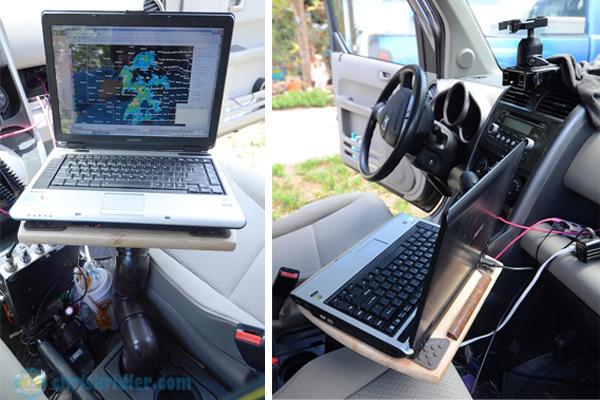
Here’s the laptop mount in the car. Photo by Chris Kridler, ChrisKridler.com, SkyDiary.com
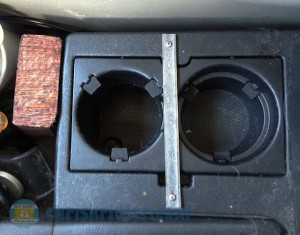
Here you can see the wood block that helps support the elbow of the pipe, the hole created by cutting off the bottom of the left cupholder, and the metal strip that holds the cupholder piece in place. Photo by Chris Kridler, ChrisKridler.com, SkyDiary.com
Update, April 23: We added a little more stability to the laptop mount last weekend in two ways. The cupholder is actually a piece that nests in a box built into the car and pops out for cleaning. I took it out and cut off the bottom of the cup where the pipe would be inserted. This allowed the pipe to rest deeper in the box and more snugly in the cupholder hole. The snug fit, however, exacerbated the cupholder piece’s desire to pop out, given that its latches aren’t designed to experience the stress of a laptop mount. So we screwed a strip of metal over the cupholder to hold it tightly in its box.
The wood block was trimmed a bit and helps support the elbow of the pipe; it’s also screwed into the box. So while this solution isn’t as elegant as Mike’s, since screws were required, I think it will work pretty well. And I can still remove the mount easily.
Posts may include affiliate links that do not add to your cost of an item but may earn me a penny here or there.
The chill has lasted longer than usual this winter here in Florida, but at least we’re not experiencing snowstorm after snowstorm. What we did get was a blast of wind in a squall line Sunday, March 24. I drove out to meet it west of Cocoa.
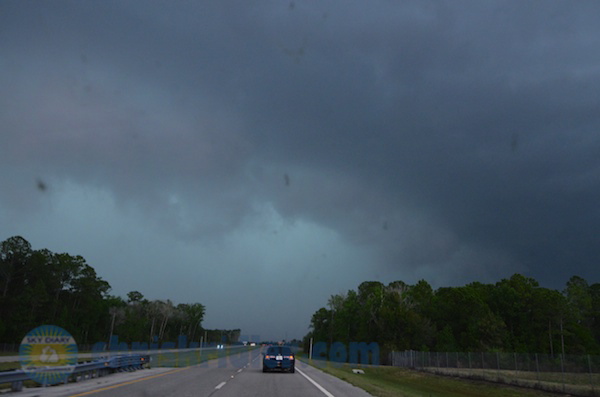
I went out to meet a squall line racing across Florida on March 24, 2013, and got a quick shot through the windshield before it overtook me. This was in the vicinity of S.R. 528 and S.R. 520, west of Cocoa, Florida.
It was moving so fast (warned with a motion of 55 mph), I couldn’t reach the area of rotation. I didn’t even have time to set up and get nice photos of the green gust front. But I did get video in my car as it blasted me.
Despite tornado warnings, the National Weather Service found only straight-line wind damage in its survey.
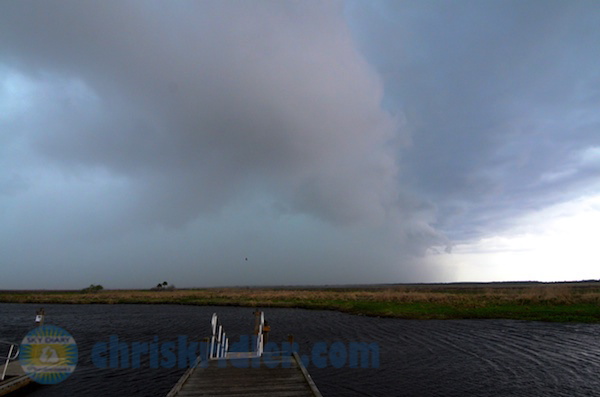
At the boat ramp across from Lone Cabbage Fish Camp, I barely had time to shoot another photo of the incoming squall line before it hit me again. At least I got a little video.
It’s not long now until the May chase! Want to see more stormy images? If you’re on Florida’s Space Coast, get a look at my storm photography on exhibit at Titusville’s Downtown Gallery, 335 S. Washington Ave. (321-268-0122), through April 16. There, you can also pick up copies of my Storm Seekers novels, Funnel Vision and Tornado Pinball – or get them online.
I’m also speaking about storm chasing and signing books at Cocoa Beach Library on April 6 at 2 p.m. The program is free.
Late edit: Just added an event – a book signing the evening of April 6 at Coco’s during Cocoa Village’s gallery walk.
Note: Post updated with images from the old Sky Diary site.
